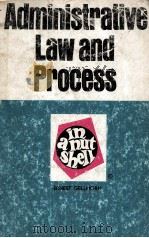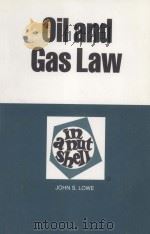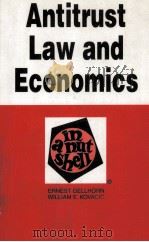《LAW AND ECONOMICS IN A NUTSHELL》
| 作者 | JEFFREY L.HARRISON 编者 |
|---|---|
| 出版 | WEST PUBLISHING GO. |
| 参考页数 | 302 |
| 出版时间 | 1995(求助前请核对) 目录预览 |
| ISBN号 | 031405586X — 求助条款 |
| PDF编号 | 813696948(仅供预览,未存储实际文件) |
| 求助格式 | 扫描PDF(若分多册发行,每次仅能受理1册) |

Chapter One.Introduction1
Chapter Two.An Introduction to Price Theory6
A.Demand, Supply and Market Equilibrium6
1.Demand6
2.Supply10
3.Market Equilibrium13
B.Elasticity15
1.Generally15
2.Incidence Analysis17
C.Perfect and Imperfect Markets20
D.Marginal Analysis Generally25
Chapter Three.Terms and Controver-sies in Law and Economics27
A.Efficiency27
1.Allocative Efficiency28
2.Pareto Optimality and Superiority30
3.Kaldor-Hicks Efficiency33
B.Rational Maximizer of Self-Interest36
C.Choices and Preferences38
1.The Wealth Effect38
C.Choices and Preferences—Continued40
2. Framing Problems40
3. False Consciousness41
D.Externalities42
1. Negative Externalities and Property Rights42
a.Negative Externalities42
b.The Tragedy of the Commons42
c.The Prisoner’s Dilemma43
2. PositiveExternalities,Free-Riding and Public Goods45
a.Positive Externalities45
b.Free Riding46
c.Public Goods47
E.Complications49
1. Lexical Ordering50
2. Exogenous and Endogenous Effects52
3. The Theory of Second Best53
Chapter Four.The Coase Theorem and Related Property Issues56
A.The Coase Theorem56
1. Allocative Implications56
2. Assignment of Rights and Distribu…tive Effects60
3. Transaction Costs62
B.Bargaining Problems64
C.The Wealth Effect67
D.Reactions to Transaction Costs70
1. Duplicating Friction-Free Exchanges70
2. Asymmetrical Transaction Costs75
E.Protecting Entitlements76
Chapter Five.Contract Law Applica-tions82
A.Contract Law: Theory and Economic Goals82
1. Exchange, the Contract Curve and Pareto Efficiency82
2. Why Does Contract Law Exist?89
3. Contract Formation and Private Risk Allocation91
4. The Economic Goals of Contract Law92
B.Contract Formation93
1. Capacity94
2. Duress97
3. Offer and Acceptance and Other For-malities99
4. The Consideration Requirement101
a.Adequacy of Consideration102
b.Nominal Consideration103
c.Gratuitous Promises104
d.Contract Modification109
C.Contract Law and Distributive Goals109
1. Exculpatory Provisions112
2. Unconscionability118
D.Contract Remedies126
1. The Efficient Breach126
2. Specific Performance130
3. Liquidated Damages133
4. The Lost Volume Seller135
E.Excuses for Non-Performance138
Chapter Six.Economics of Tort Law142
A.The Costs of Accidents and the Economics of Tort Law143
B. Liability,the Assignment of Rights and Externalities145
C.The Negligence Standard149
1. The Hand Formula149
2. Distributive Consequences150
D.Refining the Negligence Model: Contribu-tory Negligence151
1. The Conventional Doctrine151
2. Reconciling Contributory Negligence and Efficiency152
E. Refining the Negligence Standard: Com-parative Negligence154
1. Apportioned Comparative Negligence155
2. Nonapportioned Comparative Negli-gence158
F. Assumption of the Risk159
G. Strict Liability160
1. Efficiency and Strict Liability161
2. Risk-Aversion and Loss Spreading165
3. Duty to Rescue171
4. Defenses to Strict Liability172
a.Unforeseeable Misuse173
b. Unreasonable Assumption of Risk174
c. Contributory and Comparative Negligence174
H.Damages175
1. The Collateral Source Rule176
2. Future Losses176
3. Punitive Damages181
Chapter Seven.The Economics of Anti-trust183
A. The Competitive Extremes of Perfect Competition and Monopoly184
1. Demand and Supply184
2. Market Equilibrium, Producer and Consumer Surplus189
3. The Individual Firm Under Perfect Competition: The Marginal Cost=Marginal Revenue Rule193
4. Cost Curves195
5. Equilibrium and Perfect Competition199
6. Monopoly202
7. Perfect Competition and Monopoly Compared204
8. Some Limits on the Comparison207
B. Market Power and Market Definition210
1. Market Power210
2. The Lerner Index211
3. The Determinants of Market Power212
4. Market Definition and Cross-Elastici-ty213
5. Geographic Markets215
6. Supply Elasticity216
Chapter Eight.The Economics of Gov-ernment Regulation219
A. The Natural Monopoly Rationale220
1. The Theory of Natural Monopoly220
2. Agency Regulation224
a. Revenue Requirement224
b. Rate Regulation227
c. Cross-Subsidization232
3. Contestable Markets235
B. Excessive Competition236
C. The Allocation of Inherently Scarce Re-sources240
D. Reactions to Transaction Costs and Exter-nalities242
1. Rationalizing an Industry244
2. Increasing the Availability of Infor-mation245
3. Reactions to Externalities249
Chapter Nine.Public Choice257
A. Why Have a Government?258
B. Approaches to Government263
1. Utilitarianism263
2. Rawls’ Theory of Justice266
C.Why Vote at All?268
D. Problems of Ascertaining Preferences Through Voting270
1. Unanimity and Majority Voting270
2. Arrow’s Theorem and Possible Solu-tions274
a. Logrolling279
b. Single-Peaked Preferences280
E. The Economic Theory of Legislation281
1. What Do Legislators Want?281
2. Interest Groups284
3. The Market for Legislation286
INDEX291
1995《LAW AND ECONOMICS IN A NUTSHELL》由于是年代较久的资料都绝版了,几乎不可能购买到实物。如果大家为了学习确实需要,可向博主求助其电子版PDF文件(由JEFFREY L.HARRISON 1995 WEST PUBLISHING GO. 出版的版本) 。对合法合规的求助,我会当即受理并将下载地址发送给你。
高度相关资料
-

- ADMINISTRATIVE LAW AND PROCESS IN A NUTSHELL
- 1972 WEST PUBLISHING CO.
-

- THE LAW OF MEDICAL LIABILITY IN A NUTSHELL
- 1995 WEST PUBLISHING CO.
-

- Company Law in a Nutshell
- 1982 SWEET AND MAXWELL
-

- TRIAL AND PRACTICE SKILLS IN A NUTSHELL
- 1978 WEST PUBLISHING CO.
-

- LEGAL INTERVIEWING AND COUNSELING IN A NUTSHELL
- 1976 WEST PUBLISHING CO.
-

- MASS COMMUNICATIONS LAW IN A NUTSHELL
- 1977 WEST PUBLISHING CO.
-

- THE LAW OF DOMESTIC RELATIONS IN THE UNITED STATES VOL.1 SECOND EDITION
- 1987 WEST PUBLISHING CO.
-

- FAMILY LAW IN A NUTSHELL SECOND EDITION
- 1986 WEST PUBLISHING CO.
-

- CRIMINAL LAW IN A NUTSHELL
- 1975 WEST PUBLISHING CO.
-

- WILLS AND TRUSTS IN A NUTSHELL
- 1979 WEST PUBLISHING CO.
-

- LANDLORD AND TENANT LAW IN A NUTSHELL
- 1979 WEST PUBLISHING CO.
-

- LABOR ARBITRATION LAW AND PRACTICE IN A NUTSHELL
- 1979 WEST PUBLISHING CO.
-

- OIL AND GAS LAW IN A NUTSHELL SECOND EDITION
- 1988 WEST PUBLISHING CO.
-

- ANTITRUST LAW AND ECONOMICS IN A NUTSHELL FOURTH EDITION
- 1994 WEST PUBLISHING CO.
-

- BANKING AND FINANCIAL INSTITUTIONS LAW IN A NUTSHELL SECOND EDITION
- 1988 WEST PUBLISHING CO.
提示:百度云已更名为百度网盘(百度盘),天翼云盘、微盘下载地址……暂未提供。➥ PDF文字可复制化或转WORD